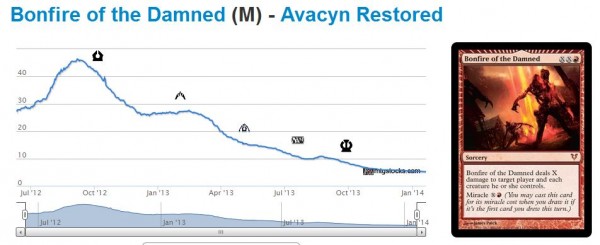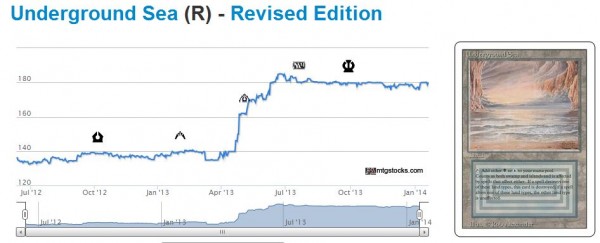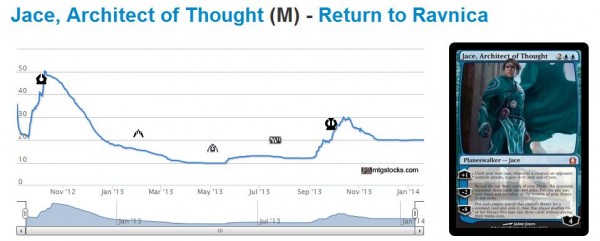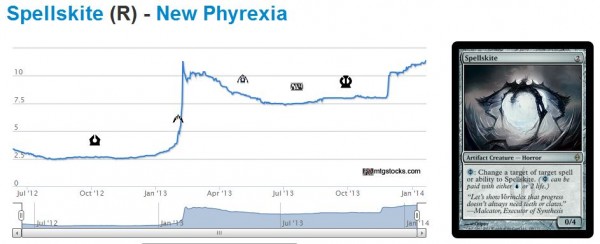Are you a Quiet Speculation member?
If not, now is a perfect time to join up! Our powerful tools, breaking-news analysis, and exclusive Discord channel will make sure you stay up to date and ahead of the curve.
One of our Quiet Speculation content leaders was cleaning through old drafts of articles in WordPress when he stumbled upon this unpublished article from January 2014. After re-reading the article, it looks like some of the content is timeless and could be helpful to readers even today. Other parts of the article make for a fun time capsule back nearly 8 years!
We hope you'll enjoy this preserved article from a very different Sig, with different goals, priorities, and quite frankly, far more time to play competitive Magic. Even his feature image depicts a much younger Sig (this was from his wedding back in 2009). -QS Staff
Entering The Arena
It’s Friday night, and once again you find yourself short a few valuable Standard cards for your deck. If only you could win a tournament or two, you could use the store credit to optimize your deck. But you consistently miss Top 8 in the final round because your deck is slightly less powerful without those critical mythic rares.
A classic catch-22.
A few years ago, I found myself in this exact situation. Although I knew the ins and outs of Magic through ten years of casual play, I was frequently intimidated by the FNM regulars at my local game store (LGS). I dabbled in drafts, but I struggled to justify paying $15 for a few bulk rares and a single-elimination tournament.
I tried to obtain cards I liked, but I just couldn’t get competitive in Standard. Trading was daunting, to say the least. Many players had pages and pages of hot rares across multiple formats. Rather than finding inspiration here, I was frequently overwhelmed and even baffled.
How did these spell-slingers obtain so many valuable cards? Were they guiltless sharks, taking advantage of every trade partner they could rope in? Perhaps their parents were rich, and they got any cards they asked for each week? Or maybe they were pros, and they had infinite store credit at the LGS?
As I was soon to learn, none of these were 100% true. Enter MTG finance.
Generating Value
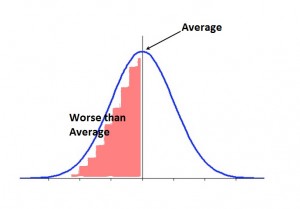 Winning tournaments is one way to add value to your collection. But let’s face it: while most players believe they are better than average, statistics cannot lie. Half of us are poorer than average, destined to a lifetime of FNM and PTQ grinding.
Winning tournaments is one way to add value to your collection. But let’s face it: while most players believe they are better than average, statistics cannot lie. Half of us are poorer than average, destined to a lifetime of FNM and PTQ grinding.
Once I realized I fell within this category, I knew I needed to find alternate ways of obtaining valuable cards I wanted to play with.
Then one day I gathered the courage to ask a local regular, “How did you get all those valuable cards? Did you open tons of boxes?”
“Through trades,” came the reply.
Inspiration hit me. By making wise investments and trading away cards near their peak for cards with more potential upside, one could slowly grind their way into a more complete collection.
All along I had been afraid to trade because I wasn’t familiar with all the trends and card values (this was before everyone had a smartphone). Rather than avoid this area of discomfort, I needed to educate myself.
Research Research Research
Enter the learning phase. Once I unlocked the knowledge that value could be obtained through MTG finance, I needed to do some major research.
The human brain is programmed to identify patterns and trends. The more I read about Magic, the more readily I could begin to formulate theories. Turns out the same few Standard decks win each month. I also discovered PTQ seasonality and the resulting price trends driven by predictable increases (and decreases) in demand.
Most importantly, I learned about one of the most significant factors that drive the giant MTG finance engine: Standard rotation.
As it turns out, many of the most desirable Standard cards tank in value as they leave the most popular format in the game. Without playability in eternal formats or strong casual demand, these cards fade into the past (and the back of people's trade binders).
Still Unprepared…Mentally
With this new knowledge, I got to work. Armed with my newfound strategy I walked into FNM with a trade binder and a plan. I had done my research throughout the week and knew exactly which cards were hot and which ones weren’t. I would trade away the garbage that was fading in popularity and pick up the most popular cards in Standard.
That’s when I uncovered two problems I hadn’t anticipated.
First of all, everyone else was looking for the same exact cards! No one wanted my recently rotated staples, they wanted the same few $30-cards I did. How could I generate value by trading into hot staples if I had to fork over $30 in value for those same cards?
Second of all, no one seemed eager to trade with me when they found out my most desirable cards “weren’t for trade.” People would frustratingly ask why I even bothered to keep my precious few Legacy staples in my trade binder. I was creating artificial hope in my trade partners by showing them cards they needed, but couldn't obtain. This would turn them off, resulting in no transactions occurring.
Clearly, I needed to shift my paradigm. I was no longer a player first and trader second. If I truly wanted to grow value within my collection I needed to be an MTG investor (or trader, or speculator) first and foremost.
Take dual lands, for instance. They are extremely powerful, sometimes essential, in every format in which they're legal. They also can be an incredibly valuable asset to a collection.
If increasing collection value is your primary goal those duals need to be put to work in your trade binder. The less you keep sacred as “not for trade,” the more negotiating tools you’ll have at your disposal.
A Couple More Sacrifices and You’re Set
You need to take emotions out of the equation. Developing attachment to certain cards is a part of the game, and we are all susceptible to clinging to cards we treasure most in our collections. But these cards should be a significant minority, and they need to be left at home. Everything you bring to the LGS needs to be fair game. Everything.
This means even pieces of your Standard deck could be traded away if it means value creation for your collection. If someone desperately needs one more $25 mythic rare for their Standard deck and you’re the only one at the store willing to trade it away, you suddenly have significant leverage.
Unless you see that $25 card going significantly higher in value, you’re much better off trading it into cards with more upside potential--even if it means no Standard FNM for you that week.
In fact, once I decided that growing my collection’s value was priority number one, I largely gave up Standard. Standard is the most popular format in Magic. As such, it’s also rapidly fluctuating and evolving.
This means rapid card value swings, which in turn means opportunity. This is especially true as Standard rotation approaches--at these times you need to be especially astute and ahead of the curve.
Months before everyone starts thinking about dumping their rotating cards, you need to be doing just that. Many cards will near their peak and begin to decline during this window, and you do not want to be holding any cards that are leaving Standard.
The Rest Is Easier
Once you overcome the emotional challenges and break attachments to your cards, the rest is pretty straightforward. Of course, with speculation running rampant and buyouts occurring weekly, the Wild West that is MTG finance has become trickier. Stick to the basics and focus on winning strategies and you’ll be building your collection in no time.
So what are these winning strategies, you ask? Well, the obvious certainly applies here. As mentioned before you’ll want to sell or trade away rotating Standard cards well before everyone else. Focus instead on picking up powerful cards in the new block which should become relevant in a Standard format with a much smaller card pool.
A good recent example of this would be Jace, Architect of Thought. While Innistrad block was around, this card was just a tad bit too weak.
After Innistrad block rotated out of Standard and the card pool shrank drastically, this planeswalker suddenly became relatively powerful. The result--a twofold increase in price and significant profits for those who were keen on the investment.
Seasonal investments are also straightforward. Some Modern cards will go up as Modern PTQ season approaches, and back down once it ends. Spellskite did just that last year, and I fully expect a repeat performance this summer with an even higher peak.
Sticking to macro trends like this will ensure you remain focused on your end goal of growing your collection’s value.
Benefits of a Financial Community
While macro trends do generally work out, today’s landscape is drastically different than it was even a few years ago when I began my endeavors in MTG finance. It seems everyone believes they can be a speculator, and with data instantaneously at people’s fingertips, the challenge of remaining ahead of the curve is greater than ever. With so many events both online and in real life, it’s become nearly impossible to stay on top of every slight shift in metagame.
Therefore to maximize the chance of success - without the pain of getting burned from rampant speculation and sudden buyouts - one needs to leverage as many resources as they have the capacity for. Whether it be Twitter, Reddit, or elsewhere, the more opinions you have access to the faster you'll learn and the fewer mistakes you'll make. As long as you develop your own opinion as well, even if it may seem counter to the general consensus.
To develop your own theses, the key is to look at macro trends and identify what specific cards are worthwhile investments and over what time horizon. Other general economic concepts ranging from basic supply and demand all the way up through Game Theory and Opportunity Cost are also sources of insight that can help guide you to the right investment decisions.
Five years ago when I entered the realm of MTG finance I relied on fervid dedication to research combined with the application of general trends. This was sufficient at the time, and it enabled me to embark on a long journey towards financial freedom in MTG.
Nowadays the number of people pursuing this same goal has increased in magnitude many times. Every trader is a shark it seems, and no one will give up value. Having a community to work with to stay ahead of the game can also provide crucial help as you get off the ground.
Whether you join the ranks of other dedicated MTG Speculators or go it alone, rest assured that with some work and ingenuity, you can fund most of your Magic exploits through trading and speculation. With enough dedication, you may even start to turn a real profit.



